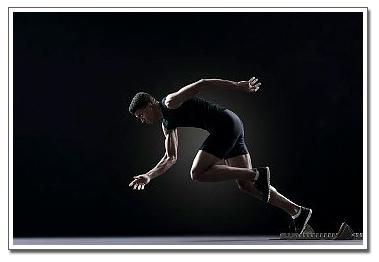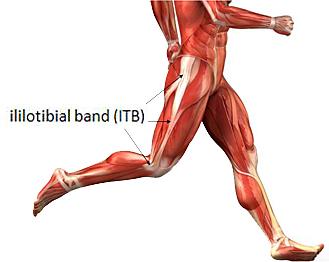 By most estimates, nearly 70 percent of runners will become injured. While many of their injuries will appear minor, they can become more serious over time if not properly treated. This is one condition that often responds well to chiropractic treatment because of the relationship between the pelvis and the muscles that attach to the pelvis. If someone has faulty pelvic mechanics then the muscles that attach to the pelvis will not work as efficiently.
By most estimates, nearly 70 percent of runners will become injured. While many of their injuries will appear minor, they can become more serious over time if not properly treated. This is one condition that often responds well to chiropractic treatment because of the relationship between the pelvis and the muscles that attach to the pelvis. If someone has faulty pelvic mechanics then the muscles that attach to the pelvis will not work as efficiently.
What is Iliotibial Band Syndrome?
Iliotibial band syndrome (ITBS) can be described as outside (lateral) knee pain that is made worse by any lower limb activities, most notably running and cycling. The iliotibial band (ITB) is a long thickened sheet of fascia that starts at the hip and extends to the knee. This band of fascia connects the tensor fascia lata and gluteus maximus muscles to the thigh and knee. The ITB gives support to the outside of the knee and patella.
Iliotibial Band (IT Band) Syndrome (ITBS) is the most common cause of knee pain in runners, by some estimates accounting for 12% of all running-related injuries. While ITBS is not quite as common in bicyclists, it does occur, and at the very least the multi-sport athlete who develops it with running may continue to aggravate it on the bike. ITBS is commonly labeled as an “overuse” injury. However this is really a misnomer, as it is generally not the fact that the knee is being used too much but rather that there are predisposing biomechanical factors causing injury with even appropriate levels of training.
What Causes ITBS?
 One potential cause of ITBS relates to ergonomic issues in running and biking. This can include, for example, prolonged running on cantered surfaces such as the side of the road (the left leg is usually affected when running against traffic.) Excessive running on a track can create asymmetrical forces in the lower extremities, because you are always running (and slightly leaning) in the same counter-clockwise direction around the curves. On the bike, two common issues are riding in clipless pedals that force the foot to toe-in (more of a problem with older-style pedals that don’t float) and/or an improper seat height.
One potential cause of ITBS relates to ergonomic issues in running and biking. This can include, for example, prolonged running on cantered surfaces such as the side of the road (the left leg is usually affected when running against traffic.) Excessive running on a track can create asymmetrical forces in the lower extremities, because you are always running (and slightly leaning) in the same counter-clockwise direction around the curves. On the bike, two common issues are riding in clipless pedals that force the foot to toe-in (more of a problem with older-style pedals that don’t float) and/or an improper seat height.
In the absence of (or in addition to) ergonomics ITBS most often results from some combination of two biomechanical factors: tight hip abductors (especially the TFL) and excessive internal rotation of the tibia. Tightness of the TFL leads to tractioning and tautness of the IT Band. Internal tibial rotation pulls the lateral condyle into position to friction the taut band. The net effect is that the lateral condyle “snags” the IT Band as it passes by with each step or pedal stroke, usually at around 30* flexion of the knee.
The underlying cause for both tight hip abductors and excess tibial rotation almost always relates to biomechanical faults of the lower extremity that becomes a factor during the gait cycle. In fact, it is rare to find hip abductors tight enough to cause ITBS without having some type of mechanical fault on the affected side. (This explains why stretching alone is rarely enough to get rid of an established case of ITBS). The two most common mechanical faults are hip joint restriction and foot dysfunction.
What Can Be Done To Treat ITBS?
Georgia Clinic of Chiropractic (Augusta, GA) has had great success treating athletes for soft tissue disorders, such as ITBS. Through specific muscle work and condition-specific adjustments, we have been able to get athletes back into competitive shape for training and competitions. Our athlete-specific treatments address the inflammation behind the condition, as well as the soft-tissue injury, followed by addressing structural issues through adjustments. In addition, the same factors that cause ITBS will also frequently cause other issues, particularly tight hip flexors and sacro-iliac joint dysfunction. All related problem areas are integrated into the treatment to ensure maximum recovery.
Many of our patients also report that their follow-up care has proven to be just as invaluable, as they have noted faster running times or greater endurance after having undergone ‘quick tune-ups’ just before an event or competition. Whether you are a weekend warrior or a competitive athlete, treatments at Georgia Clinic of Chiropractic are not only condition-specific, but they are tailored to your specific sport, and we integrate both into your own unique treatment. Call us today for a complimentary consultation to discuss how our clinic can help you with your specific condition and overall performance.
The Georgia Clinic of Chiropractic Blog is written by Dr. Mark Huntsman.
Georgia Clinic of Chiropractic is conveniently located off Furys Ferry Rd in Martinez, Georgia and provides quality chiropractic care to the Augusta, Martinez, and Evans communities. Visit our main website at www.georgia-clinic.com.
Choose several options to schedule your appointment: call (706) 814-5053, use our online voicemail, or use our online form.
